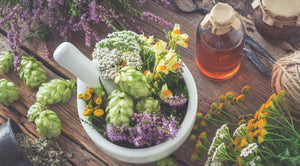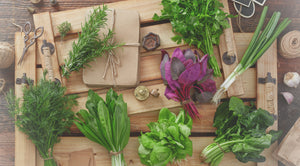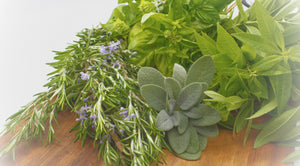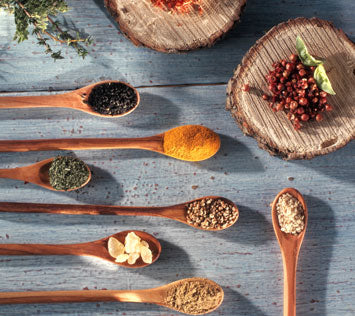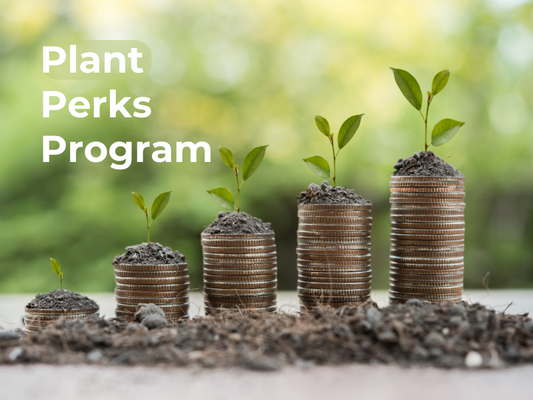
It’s easy to feel a little intimidated when planning your herb garden. But, want to know a secret? Herbs are some of the easiest and most prolific plants you can grow! Once you get them off to a good start there’s very little else to do except wait for the harvest and enjoy the burst of amazing flavor they bring to just about anything. Here we’ve put together some tips to make your herb garden a glowing and tasty success.
The thing about herbs is you can put them just about anywhere and they will thrive. Depending on the types of herbs you choose to grow your first herb garden can easily be a container garden on the balcony of your apartment or condo, or a dedicated space in your yard. Herb plants are so lovely you may want to put them in your flower bed and add a little curb appeal that’s as tasty as it is becoming.
Wherever you choose to start your herb garden, select a spot with the right amount of sun. Depending on the zone in which you live, make sure the sun isn’t searing in the afternoon. For areas of the country where the sun is more intense than others you can choose to plant your first herb garden earlier than in other areas. For instance in the southeastern U.S. you can typically plant your herbs earlier in the season. In the northern states your growing season is later and shorter, but you will experience success nonetheless. Know your zone.
If the area of your yard or porch is in direct afternoon sun you may need to move to a location that gets more filtered or early morning sun. Whichever area you determine is best for your herb garden make sure it’s easy to get to so you can tend it as needed or run out and grab a handful of basil for your spaghetti sauce or some mint for a refreshing mojito.
Pick which herbs are your favorites and read up on them. Usually the basic culinary bundle of basil, rosemary, sage, parsley and thyme are good beginner herbs. Herbs typically don’t need as much care as vegetables or flowers but you do want to make sure you understand specific needs of the herbs you want to plant. Each plant will have specific requirements for sun and soil. Some herbs do far better in dry climates and some thrive best in a more humid atmosphere. If you’re planting your herbs together in containers make sure they share the same soil and sun needs.
Most herbs don’t require a super-rich soil. Compost-rich potting soil isn’t necessary. Regular soil is sufficient for your herbs, although you may wish to mix in some standard organic potting fertilizer if the soil isn’t already enriched with it. Simply dig the proper size hole, pop in your plant and surround it with garden soil and it should be just fine. The only time you should amend the soil is if you have heavy clay soil. You will need to mix in some garden soil to allow for proper drainage.
A good rule to go by for your first herb garden is to water once per week, in the cooler morning hours so the moisture won’t evaporate and the water has a chance to soak the roots. If you’re experiencing extreme heat or lack of rain you may consider watering your herbs twice per week until cooler temps and rain return.
Herbs don’t normally need much in the way of fertilizer, which is why they make such a great first garden. But, if your plants begin to look pale or weak and limp during the peak of the season when they should be thriving, apply an organic liquid fertilizer athalf strengthevery few weeks.
Pruning encourages new growth which is always good for herbs. The new growth will make your plants full and busy. Although pruning can be difficult for a gardener to cut perfectly healthy trimmings from the plant it is necessary to maintain the plant’s health. Herbs will eventually flower and when that happens no new growth will come from that stem. Regular pruning prevents flowering and extends the growing season of the plant.
If you do allow your herbs to flower that’s fine too! Herb flowers bring on the pollinators and that’s a good thing.
Tips for our Popular plants that are EXTRA-Extraordinary !
Basil 'Holy Green':
Since this plant is so important – a sacred herb and necessary to Hindu traditions – it is important to grow it successfully indoors.Holy Basil is a tropical herb – they cannot survive a frost. Therefore, if you are unable to leave this plant outdoors because of your climate, care must be taken in growing it as a houseplant.These tender herbs prefer daytime temperatures between 77 and 86 degrees. The nighttime temperatures must be above 55 degrees. 6 to 8 hours of sunlight is essential and it is important to rotate the pot so that the plant grows evenly.Allow the soil to dry out between waterings, and always use a well-draining potting soil. When growing indoors, keep an eye out for spider mites. They live on the undersides of the leaves, and suck on the plant's juices leaving tell-tale tiny white spots. These pests thrive in hot and dry conditions, so make sure to mist your plants regularly.If you do have a problem, you can control it with a soap spray:
- Dissolve 1 -2 tablespoons of mild flaked soap (Ivory) in a gallon of warm water
- Spray the plants weekly, making sure to spray the undersides of the leaves
When the weather allows, take your plants outdoors as they will thrive!
Lavender:
To grow Lavender successfully, you need to understand its origins: a native of the Mediterranean, Lavender loves dry, sunny and rocky habitats. Don't worry! Lavenders will grow in many types of conditions, but you MUST have the following:
- Well Drained Soil
- Sunny Location
Lavenders hate 'wet feet' – too much moisture is the main reason for a lavender's downfall. Many varieties are hardy to Zone 5, so it is not the cold that kills but rather the amount of moisture in the soil.
If you are growing lavender in a pot, the plant will require more water. Let the soil dry completely between waterings, and we recommend bottom watering in which the pot is placed in the sink with 1” or so of water. Allow the plant to 'soak up' water through its roots rather than watering the surface of the soil. You want to avoid unnecessary moisture, so keep the foliage dry.
Pruning should take place in the early spring.
Cilantro:
A word of caution: cilantro does not like extreme heat. If you are growing it in a milder climate, you should have no problem. However, there are ways to have success in warmer climates.
Cilantro is an herb that prefers cool weather – if you are in a cooler climate, plant in full sun. If you are in a warmer climate, make sure to provide shade: it will grow best with morning sun, and shade in the hot afternoons. In order to prevent it from bolting (prematurely going to seed) too early in the season, make sure to mulch the top of the roots which will help keep the soil cooler. If you plant cilantro close together, the roots will be somewhat shaded. Under the right conditions, your cilantro should last 10-12 weeks before flowering.
Never let your plants dry out; water thoroughly but make sure that you have well drained soil. No wet feet! Cilantro HATES humidity, so make sure that they are planted where air can circulate freely.
Cilantro will reseed itself in your garden if you allow the plants to flower and develop seeds. Harvest coriander seeds as soon as they turn brown by shaking the seed heads over a paper bag. Allow the seeds to dry and store them in airtight jars.
Bay:
The first thing to know about Bay Trees: they are not the prettiest plant in the world. Consider their origin, and then appreciate them for their rugged and tenacious spirit. Bays are native to the wind swept shores of the Mediterranean – the dry and rocky slopes are home to these plants with historical significance as well as a wonderfully rich culinary heritage. Bays will grow almost anywhere, but care must be taken. Please do not call us to tell us that THEY DON’T LOOK GOOD because, quite frankly, they don’t look that good!
Bays appreciate well draining soil, and will be perfect in a pot (remember, holes are essential for proper drainage). They can get a little root bound (cramped in the pot) – but if you want a bigger plant, keep on transplanting as your bay grows. And speaking of growth, it will grow VERY SLOWLY.
Water well, let it drain well and then let it dry slightly between waterings. It will grow happily outside, providing a bit of shade from the harsh afternoon soon. Make sure to bring it indoors before a heavy frost. Give it at least 6 – 8 hours of sunlight, and keep it cool. Keep an eye out for any pests that may try to make its home on your plant – scale can be a problem. And once the weather is warm, the danger of frost is over, give it a prune and put it outdoors for the spring, summer and fall. Year round if you are in a warm climate.
Patchouli:
Patchouli is a member of the mint family; a shrubby herb that thrives in Zones 9 – 11. This plant likes to be warm, so keep it where the temperatures rarely dip below 60 degrees. It is a native of India, therefore it is happiest in hot, humid conditions. Moist soil and high humidity!
However, it is an extremely easy plant to grow indoors, as long as you provide it with enough full sun (6-8 hours a day). Well-drained soil is a must. So, if you are in Zones 8 or lower, keep it outdoors as long as your nights are warm. Full sun with a bit of afternoon shade is best, and bring your plant indoors when the temperatures drop below 60 degrees. Do not be alarmed if it drops some of its leaves during this transition. As long as you provide the plant with enough sun, it will begin to grow new leaves quickly
Eucalyptus:
Full sun is a must for Eucalyptus. It needs to dry completely before waterings, and avoid humid conditions. Do not mist the foliage.
Hardy between Zones 7 and 11 (but it must be given winter protection, and planted out of the wind), Eucalyptus must be brought indoors before any threat of frost. It will grow indoors in a container, but must be given 6-8 hours of direct sunlight. A monthly feeding of a well-balanced fertilizer is suggested for indoor growing.
Although Eucalyptus does not have a lot of ‘issues’, the one area of concern is fungus. It is susceptible to Silver Leaf, a fungal disease usually caused by pruning. The most effective, non-chemical method of dealing with this threat is to prune your Eucalyptus in the summer, when fewer spores are produced and pruning wounds (which are the entry point for spores) heals much faster.
Give proper care, Eucalyptus can grow into a gorgeous, stand along specimen tree that is outstanding in the garden.

